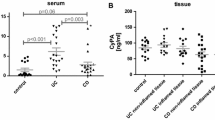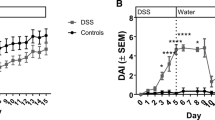Abstract
Background
Matrix metalloproteinases (MMPs) constitute a family of enzymes capable of degrading various extracellular matrices (ECM) and basement membrane components playing a role in ECM turnover. They activate and degrade signaling molecules, such as cytokines and chemokines. MMPs are involved in inflammation and have been implicated in tissue degradation and repair occurring in inflammatory bowel disease. The aim of this study was to investigate the MMP profile of intestinal Crohn's disease (CD) patients before and after immunosuppressive treatment (anti-TNF-α agents or corticosteroids and conventional immunosuppressants azathioprine or methotrexate) to learn more about the therapeutic pathways for immunosuppressive agents.
Methods
Expression of MMP-1, MMP-7, MMP-9, MMP-10, and MMP-26 and tissue inhibitors of metalloproteinases (TIMP)-1 and TIMP-3 was studied by immunohistochemistry in pretreatment and post-treatment tissue samples. Semiquantitative immunohistochemical scores were tested for correlations with fecal and serum inflammation markers as well as endoscopic and clinical disease activity scores.
Results
Neutrophil MMP-9 (p = 0.039) and MMP-26 (p = 0.030) and stromal TIMP-1 (p = 0.041) and TIMP-3 (p = 0.029) decreased along with treatment. However, expression of TIMP-3 by enterocytes tended to increase. Total histological score demonstrated positive correlation with neutrophil MMP-9 (p = 0.000), MMP-26 (p = 0.014), and macrophage TIMP-1 (p = 0.001). Calprotectin followed a similar pattern with stromal MMP-26 (p = 0.011), TIMP-1 (p = 0.000), and TIMP-3 (p = 0.001). Crohn's disease endoscopic index of severity (CDEIS) value correlated positively with macrophage TIMP-1 (p = 0.007) and stromal TIMP-3 (p = 0.005). Epithelial TIMP-3 presented with negative correlations with CDEIS (p = 0.006) and C-reactive protein values (p = 0.004).
Conclusions
Our results suggest that immunosuppressive drugs modulate disease activity in CD by downregulation of MMP-9 and MMP-26 positive neutrophils and stromal TIMP-1 and TIMP-3.


Similar content being viewed by others
Abbreviations
- CD:
-
Crohn's disease
- MMP:
-
matrix metalloproteinase
- TIMP:
-
tissue inhibitor of metalloproteinase
- CDAI:
-
Crohn's disease activity index
- CDEIS:
-
Crohn's disease endoscopic index of severity
References
Shanahan F (2002) Crohn's disease. Lancet 359:62–69
Podolsky DK (2002) Inflammatory bowel disease. N Engl J Med 347:417–429
Taylor CT, Keely SJ (2007) The autonomic nervous system and inflammatory bowel disease. Auton Neurosci 133:104–114
Parks WC, Wilson CL, López-Boado YS (2004) Matrix metalloproteinases as modulators of inflammation and innate immunity. Nat Rev Immunol 4:617–629
Ravi A, Garg P, Sitaraman SV (2007) Matrix metalloproteinases in inflammatory bowel disease: boon or a bane? Inflamm Bowel Dis 13:97–107
Saarialho-Kere UK, Vaalamo M, Puolakkainen P et al (1996) Enhanced expression of matrilysin, collagenase, and stromelysin-1 in gastrointestinal ulcers. Am J Pathol 148:519–526
Heuschkel RB, MacDonald TT, Monteleone G et al (2000) Imbalance of stromelysin-1 and TIMP-1 in the mucosal lesions of children with inflammatory bowel disease. Gut 47:57–62
Kirkegaard T, Hansen A, Bruun E et al (2004) Expression and localisation of matrix metalloproteinases and their natural inhibitors in fistulae of patients with Crohn's disease. Gut 53:701–709
Warnaar N, Hofker HS, Maathuis MH et al (2006) Matrix metalloproteinases as profibrotic factors in terminal ileum in Crohn's disease. Inflamm Bowel Dis 12:863–869
Bailey CJ, Hembry RM, Alexander A et al (1994) Distribution of the matrix metalloproteinases stromelysin, gelatinases A and B, and collagenase in Crohn's disease and normal intestine. J Clin Pathol 47:113–116
Baugh MD, Perry MJ, Hollander AP et al (1999) Matrix metalloproteinase levels are elevated in inflammatory bowel disease. Gastroenterology 117:814–822
Stumpf M, Cao W, Klinge U et al (2005) Reduced expression of collagen type I and increased expression of matrix metalloproteinases 1 in patients with Crohn's disease. J Invest Surg 18:33–38
Srivastava MD, Kulaylat MN (2004) Gene expression profiles of late colonic Crohn's disease. J Med 35:233–255
Vaalamo M, Karjalainen-Lindsberg ML, Puolakkainen P et al (1998) Distinct expression profiles of stromelysin-2 (MMP-10), collagenase-3 (MMP-13), macrophage metalloelastase (MMP-12), and tissue inhibitor of metalloproteinases-3 (TIMP-3) in intestinal ulcerations. Am J Pathol 152:1005–1014
Gill SE, Parks WC (2008) Metalloproteinases and their inhibitors: regulators of wound healing. Int J Biochem Cell Biol 40:1334–1347
Bister VO, Salmela MT, Karjalainen-Lindsberg ML et al (2004) Differential expression of three matrix metalloproteinases, MMP-19, MMP-26, and MMP-28, in normal and inflamed intestine and colon cancer. Dig Dis Sci 49:653–661
Pender SL, Li CK, Sabatino AD et al (2006) Role of macrophage metalloelastase in gut inflammation. Ann N Y Acad Sci 1072:386–388
Meijer MJ, Mieremet-Ooms MA, van Hogezand RA et al (2007) Role of matrix metalloproteinase, tissue inhibitor of metalloproteinase and tumor necrosis factor-alpha single nucleotide gene polymorphisms in inflammatory bowel disease. World J Gastroenterol 13:2960–2966
Mary JY, Modigliani R (1989) Development and validation of an endoscopic index of the severity for Crohn's disease: a prospective multicentre study. Groupe d'Etudes Therapeutiques des Affections Inflammatoires du Tube Digestif (GETAID). Gut 30:983–989
Best WR, Becktel JM, Singleton JW et al (1976) Development of a Crohn's disease activity index. National Cooperative Crohn's Disease Study. Gastroenterology 70:439–444
Sostegni R, Daperno M, Scaglione N et al (2003) Review article: Crohn's disease: monitoring disease activity. Aliment Pharmacol Ther 17:11–17
Sipponen T, Savilahti E, Kolho KL et al (2008) Crohn's disease activity assessed by fecal calprotectin and lactoferrin: correlation with Crohn's disease activity index and endoscopic findings. Inflamm Bowel Dis 14:40–46
D'Haens GR, Geboes K, Peeters M et al (1998) Early lesions of recurrent Crohn's disease caused by infusion of intestinal contents in excluded ileum. Gastroenterology 114:262–267
Kolho KL, Raivio T, Lindahl H et al (2006) Fecal calprotectin remains high during glucocorticoid therapy in children with inflammatory bowel disease. Scand J Gastroenterol 41:720–725
von Roon AC, Karamountzos L, Purkayastha S et al (2007) Diagnostic precision of fecal calprotectin for inflammatory bowel disease and colorectal malignancy. Am J Gastroenterol 102:803–813
Bister V, Mäkitalo L, Jeskanen L et al (2007) Expression of MMP-9, MMP-10 and TNF-alpha and lack of epithelial MMP-1 and MMP-26 characterize pyoderma gangrenosum. J Cutan Pathol 34:889–898
Impola U, Jeskanen L, Ravanti L et al (2005) Expression of matrix metalloproteinase (MMP)-7 and MMP-13 and loss of MMP-19 and p16 are associated with malignant progression in chronic wounds. Br J Dermatol 152:720–726
Kuivanen T, Jeskanen L, Kyllönen L et al (2006) Transformation-specific matrix metalloproteinases, MMP-7 and MMP-13 are present in epithelial cells of keratoacanthomas. Mod Pathol 19:1203–1212
Isaka K, Nishi H, Nakai H et al (2003) Matrix metalloproteinase-26 is expressed in human endometrium but not in endometrial carcinoma. Cancer 97:79–89
Salmela MT, MacDonald TT, Black D et al (2002) Upregulation of matrix metalloproteinases in a model of T cell mediated tissue injury in the gut: analysis by gene array and in situ hybridisation. Gut 51:540–547
Manfredi MA, Zurakowski D, Rufo PA et al (2008) Increased incidence of urinary matrix metalloproteinases as predictors of disease in pediatric patients with inflammatory bowel disease. Inflamm Bowel Dis 14:1091–1096
Gao Q, Meijer MJ, Schluter UG et al (2007) Infliximab treatment influences the serological expression of matrix metalloproteinase (MMP)-2 and -9 in Crohn's disease. Inflamm Bowel Dis 13:693–702
Meijer MJ, Mieremet-Ooms MA, van Duijn W et al (2007) Effect of the anti-tumor necrosis factor- alpha antibody infliximab on the ex vivo mucosal matrix metalloproteinase-proteolytic phenotype in inflammatory bowel disease. Inflamm Bowel Dis 13:200–210
Cordiali-Fei P, Trento E, D'Agosto G et al (2007) Effective therapy with anti-TNF-alpha in patients with psoriatic arthritis is associated with decreased levels of metalloproteinases and angiogenic cytokines in the sera and skin lesions. Ann N Y Acad Sci 1110:578–589
Klimiuk PA, Sierakowski S, Domyslawska I et al (2004) Effect of repeated infliximab therapy on serum matrix metalloproteinases and tissue inhibitors of metalloproteinases in patients with rheumatoid arthritis. J Rheumatol 31:238–242
Vandooren B, Kruithof E, Yu DT et al (2004) Involvement of matrix metalloproteinases and their inhibitors in peripheral synovitis and down-regulation by tumor necrosis factor alpha blockade in spondylarthropathy. Arthritis Rheum 50:2942–2953
Marchenko GN, Ratnikov BI, Rozanov DV et al (2001) Characterization of matrix metalloproteinase-26, a novel metalloproteinase widely expressed in cancer cells of epithelial origin. Biochem J 356:705–718
Uría JA, López-Otín C (2000) Matrilysin-2, a new matrix metalloproteinase expressed in human tumors and showing the minimal domain organization required for secretion, latency, and activity. Cancer Res 60:4745–4751
Li W, Savinov AY, Rozanov DV et al (2004) Matrix metalloproteinase-26 is associated with estrogen-dependent malignancies and targets alpha1-antitrypsin serpin. Cancer Res 64:8657–8665
Bister V, Salmela MT, Heikkilä P et al (2005) Matrilysins-1 and -2 (MMP-7 and -26) and metalloelastase (MMP-12), unlike MMP-19, are up-regulated in necrotizing enterocolitis. J Pediatr Gastroenterol Nutr 40:60–66
Matsuno K, Adachi Y, Yamamoto H et al (2003) The expression of matrix metalloproteinase matrilysin indicates the degree of inflammation in ulcerative colitis. J Gastroenterol 38:348–354
McKaig BC, McWilliams D, Watson SA et al (2003) Expression and regulation of tissue inhibitor of metalloproteinase-1 and matrix metalloproteinases by intestinal myofibroblasts in inflammatory bowel disease. Am J Pathol 162:1355–1360
Stallmach A, Giese T, Schmidt C et al (2004) Cytokine/chemokine transcript profiles reflect mucosal inflammation in Crohn's disease. Int J Colorectal Dis 19:308–315
Schmidt C, Giese T, Hermann E et al (2007) Predictive value of mucosal TNF-alpha transcripts in steroid-refractory Crohn's disease patients receiving intensive immunosuppressive therapy. Inflamm Bowel Dis 13(1):65–70
Di Sabatino A, Pender SL, Jackson CL et al (2007) Functional modulation of Crohn's disease myofibroblasts by anti-tumor necrosis factor antibodies. Gastroenterology 133:137–149
Sipponen T, Savilahti E, Kärkkäinen P et al (2008) Fecal calprotectin, lactoferrin and endoscopic disease activity in monitoring anti-TNF-alpha therapy for Crohn's disease. Inflamm Bowel Dis 14:1392–1398
Isaksen B, Fagerhol MK (2001) Calprotectin inhibits matrix metalloproteinases by sequestration of zinc. Mol Pathol 54:289–292
Acknowledgments
We thank Ms. Alli Tallqvist for the skillful technical assistance. This study was supported by the Academy of Finland, the Sigrid Juselius Foundation, Finska Läkaresällskapet, the Finnish Cultural Foundation (T.S, L.M.), the Mary and George C. Ehrnrooth Foundation (T.S.), the Orion-Farmos Research Foundation (T.S.), the Päivikki and Sakari Sohlberg Foundation (K.-L.K.), the Pediatric Research Foundation (K-L.K), Helsinki University Central Hospital Research Fund and Biomedicum Foundation (L.M.), Finland, and the Swedish Research Council (U.S-K.), Sweden.
Author information
Authors and Affiliations
Corresponding author
Rights and permissions
About this article
Cite this article
Mäkitalo, L., Sipponen, T., Kärkkäinen, P. et al. Changes in matrix metalloproteinase (MMP) and tissue inhibitors of metalloproteinases (TIMP) expression profile in Crohn's disease after immunosuppressive treatment correlate with histological score and calprotectin values. Int J Colorectal Dis 24, 1157–1167 (2009). https://doi.org/10.1007/s00384-009-0756-5
Accepted:
Published:
Issue Date:
DOI: https://doi.org/10.1007/s00384-009-0756-5




